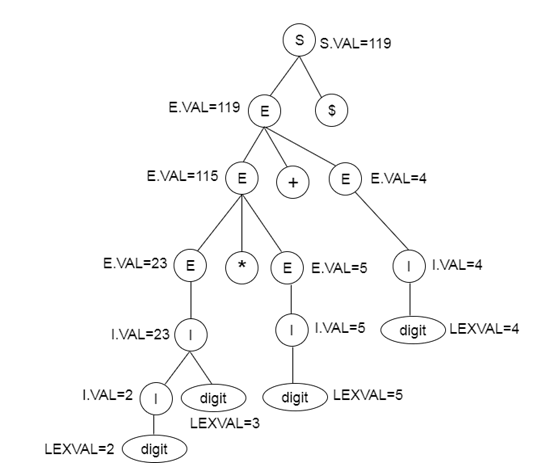Syntax-directed translation refers to a method of compiler implementation where the source language translation is completely driven by the parser. A common method of syntax-directed translation is translating a string into a sequence of actions by attaching one such action to each rule of a grammar. Thus, parsing a string of the grammar produces a sequence of rule applications. SDT provides a simple way to attach semantics to any such syntax.
SDT fundamentally works by adding actions to the productions in a context-free grammar, resulting in a Syntax-Directed Definition (SDD). Actions are steps or procedures that will be carried out when that production is used in a derivation. A grammar specification embedded with actions to be performed is called a syntax-directed translation scheme (sometimes simply called a ‘translation scheme’).
Each symbol in the grammar can have an attribute, which is a value that is to be associated with the symbol. Common attributes could include a variable type, the value of an expression, etc. Given a symbol X, with an attribute t, that attribute is refer to as X.t.
Thus, given actions and attributes, the grammar can used for translating strings from its language by applying the actions and carrying information through each symbol’s attribute.
How do we read source program?
Language processor reads with complete source program written in the high level language as whole in one go. It into an equivalent program in machine language is refer as a Compiler and it is the source code translate to object code successfully if it is free of errors.
What is a lex file?
A LEX file is a lexicon data file create by Linguistic Library, an Adobe development kit use add linguistic services, such as spelling and grammar checkers, to Adobe products. LEX files are use to store language-specific data for document validation in Adobe products.
What is output of Lex tool?
Lex is a program that generates lexical analyzer. It is use with YACC parser generator. The lexical analyzer is a program that transforms an input stream into a sequence of tokens. It reads the input stream and produces the source code as output through implementing the lexical analyzer in the C program.
What is the use of lex tool?
Lex can perform simple transformations by itself but its main purpose is to facilitate lexical analysis, the processing of character sequences such as source code to produce symbol sequences called tokens for use as input to other programs such as parsers.
How can a source code be written?
To write a source code, all you really need is a simple text editor – like the Notepad on Windows or Text Edit on Mac. This way, source code can saved as plain text (e.g. in ASCII coding or with UTF-8 encoding) with the correct file name ending for the programming language.
How important is source code?
Source code serves the needs of companies who have procedures in place. That they want to retain regardless of the software installed. Some companies consider source code as a way to guarantee. That the software changes as their company’s needs change in the future.
What is the use of source code ?
Source code is primarily use as input to the process that produces an executable program. (i.e., compilation or interpretation). It is also use as a method of communicating algorithms between people (e.g., code snippets in books).
Is lex a compiler?
Lex is a tool in lexical analysis phase to recognize tokens using regular expression. Lex tool itself is a lex compiler.
What is lex in theory of computation?
Lex is a computer program that generates lexical analyzers, which is commonly use with the YACC parser generator. Lex reads an input stream specifying the lexical analyzer. And outputs source code implementing the lexer in the C programming language.





